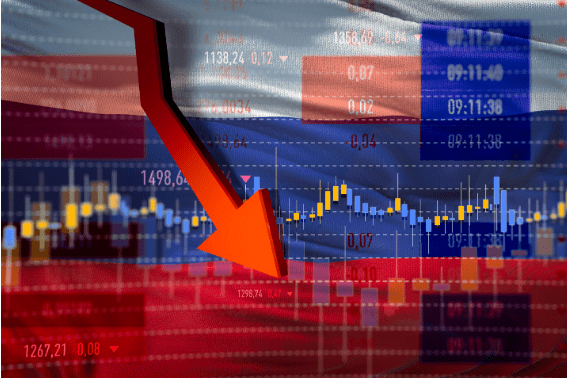- Home
- Trade News
- Russia’s economy is forecast ...

In the weeks after Russia’s invasion of Ukraine and the subsequent increase of Western sanctions in response to the invasion, the Russian economy plunged into a spiral.
In October 2022, Russian oil shipments hit a new low in the wake of the Ukraine conflict. In the spring of last year, the Moscow Exchange recorded its worst decline ever, the ruble’s exchange rate collapsed to all-time lows, and widespread panic spread across the financial system. You can read more about the effects of the war on Russia’s trading goods here.
The Russian Central Bank (CBR) acted swiftly to avert a full-blown financial catastrophe by imposing significant limitations on the capital and foreign currency markets, and eventually succeeded in bringing about market stability. While the official exchange rate of the ruble to the US dollar rose by 6% at the end of the year, the MICEX index fell by 43%.
This decline in GDP in Russia first appeared in the last spring season. According to early estimates from the ministry of economic development, it has contracted by 4-5% annually in recent months. Consensus Economics, which takes an average of projections from authoritative institutions, predicts a 3.5 percent slowdown in economic output in 2022 in its latest composite estimate.
The oil industry and Russia’s economy

The oil industry, which is crucial to Russia’s economy, has continued to underpin the country’s overall economic growth. The oil output increased by 2% from January to November, compared to the same period in the previous year. Much of what is produced is sent abroad. It wasn’t until the latter few months of 2017 that Russia’s crude oil shipments started to decrease.
The EU’s restriction on Russian crude oil imports went into effect in December, but the prohibition on petroleum product imports won’t take effect until the start of February. Russia actively sought for new oil export markets in 2017, with India being a primary focus. In fact, at the end of June 2021, Russia’s share of India’s total oil imports grew to 14%.
Russian export earnings reached a record high on the back of rising commodity prices, but imports began to fall precipitously last spring as a result of sanctions and the devaluation of the ruble. Since capital flight from Russia has been curbed thanks to sanctions and restrictions, most of the country’s record export revenues have stayed there. This resulted in a rapid rise in the value of the ruble at first, but the situation has since changed.
The preliminary data shows that both the volume and the price of Russian oil shipments dropped in December. The ruble has fallen in value and Russia’s current account surplus has shrunk as a result of falling export receipts.
Russia’s government finances have weakened along with oil exports and the economy. The federal budget deficit in 2022 will be much greater than predicted, according to Finance Minister Anton Siluanov’s latest evaluation. It will hit 2% of GDP.
In order to cover the growing deficit, the government issued more domestic bonds in the latter months of 2022. Some of the largest commodity producers in Russia, including gas giant Gazprom, were hit with windfall taxes that brought in significant money for the government at the year’s culmination.
Conclusion
Recent major projections have Russian GDP declining by 3-4% this year, making 2023 a particularly dismal year for the Russian economy. As sanctions take effect, exports are expected to fall dramatically. The federal budget for this fiscal year predicts a continuation of current levels of government expenditure.
Since most projections predict that Russian inflation would average 4-6% in 2023, this suggests a drop in real terms. The government budget deficit is projected to rise to at least 2% of GDP in 2023, regardless of whether or not spending changes. As long as Russia maintains its military presence in Ukraine, there is a significant possibility of even worse performance.
Use TradeData.Pro for market monitoring.

Reduce the trade risks that might affect your company’s operations and traded commodities by keeping a careful eye on market dynamics and anticipating possible difficulties.
Get a better understanding of the worldwide market by examining demand and supply chains, company import and export statistics, and other trade data.
With a personalised trade data dashboard, you can find international trading partners by searching import/export firms, country data, and market analytics reports.
Click here to view all the features of our platform.
The most trustable and reliable source for Trade Data.
TradeData.Pro is a reliable and trustworthy source of trade data proudly made in Singapore, a country known for its stable political climate and trade-driven economy. Presented by Commodities Intelligence Centre, a government-linked company and a joint venture of Zall Smartcom, SGX, and GeTS, TradeData.Pro has received positive feedback from the market since its launch in 2018 for its extensive coverage, affordability, and fast response. The platform has been awarded the Singapore Quality Class in 2020 and the Stevie Award Gold in 2021.
Traditionally, obtaining critical data to reveal trends, identify market opportunities, track competitors, buyers, and suppliers, and better understand the potential of the supply chain has been a challenge. However, the detailed shipment information that is part of government import and export filing requirements does exist and forms the core of global trade. TradeData.Pro has gathered and packaged this information as business intelligence, which helps companies understand the flow of goods across borders and features the world’s largest searchable trade database. TradeData.Pro reviews, standardizes, and cleans data and delivers it in an intuitive format, making it easier for businesses to access.
Businesses interested in staying updated on Vietnam, the hottest industry lately, can access all relevant information on the TradeData.Pro platform. They can find the exact product they’re interested in by checking out the trade database demo at https://tradedata.pro/asia-trade-data/vietnam-import-export-data/. To learn more about accessing new markets, visit https://tradedata.pro/trade-database-demo/.
Additionally, businesses can check out this article to learn how to use TradeData.Pro to access Global Trade Markets: https://blog.tradedata.pro/say-hello-to-our-new-release-of-tradedata-pro/. To understand how TradeData.Pro works, watch the video below or visit https://www.youtube.com/watch?v=tITfUvjs6Gc.
Business Economy Export Global Import International Trade Markets Recession Russia Trade Data Pro Worldwide







2 replies on “Russia’s economy is forecast to go into recession until all of 2023”
[…] be your next destination for your global energy business. Because of the Russia-Ukraine war and forecasted recession in 2023, you might still want to assess the risk associated with it. By understanding the impact of the […]
[…] your next destination to start your import-export business. Because of the Russia-Ukraine war and forecasted recession in 2023, you might still want to assess the risk associated with it. By understanding the impact of the […]